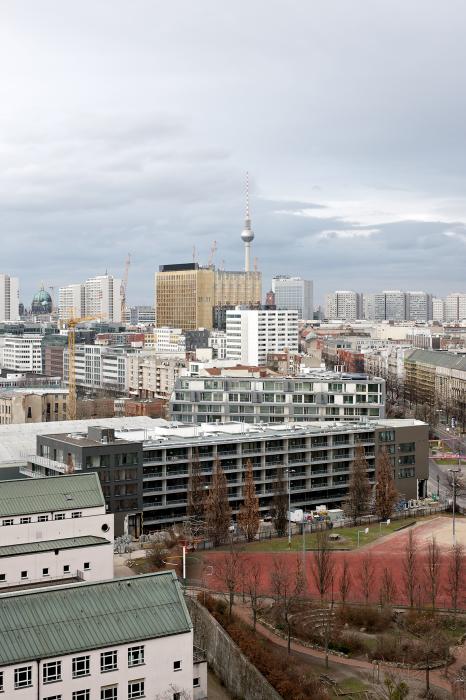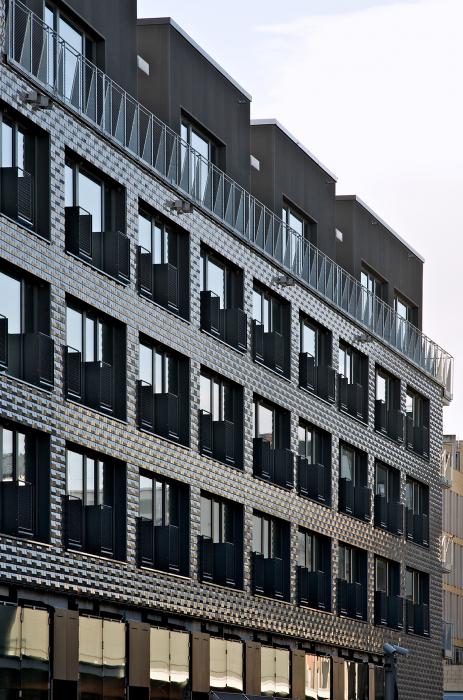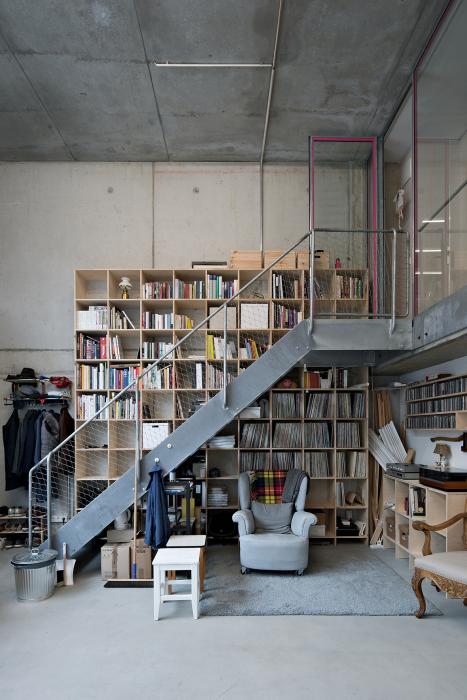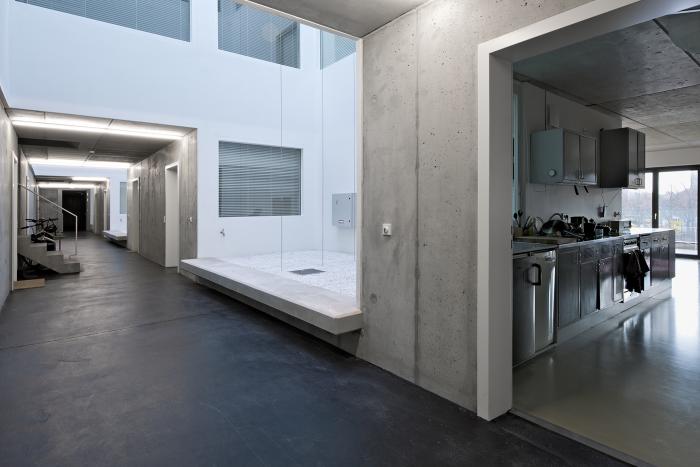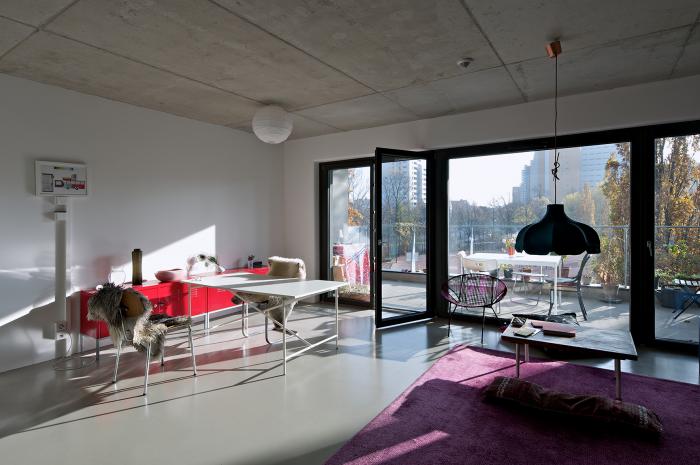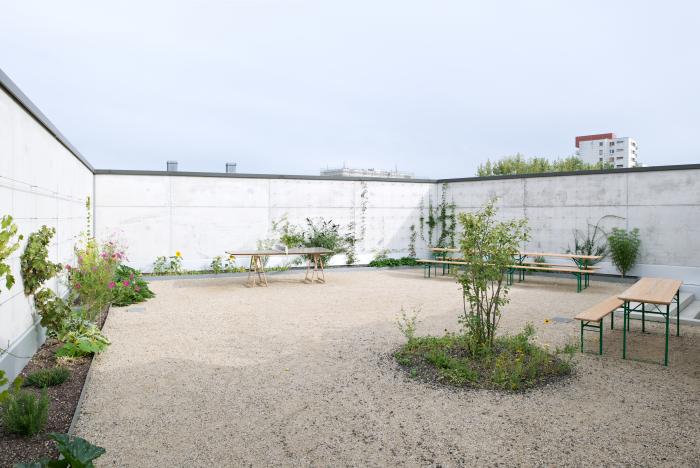I. SUMMARY INFORMATION
Project
269880
Status
Submitted
Award category
Techniques, materials and processes for construction and design
You want to submit
NEW EUROPEAN BAUHAUS AWARDS : existing completed examples
Project title
IBeB
Full project title
Residential and studio building at the former Berlin flower market (IBeB)
Description
The main idea for the Residential and studio building at the former Berlin flower market (IBeB), which was initiated by the architects in cooperation with a cooperative, is to offer a mix of live and work units that meets the needs of artists and creative professionals, among others. Moreover, the comparatively low land price allowed the cross-subsidisation of cooperative residential and studio spaces within the project, which can be let at a sustainable rent.
Photography: Andrew Alberts
Where was your project implemented in the EU?
Germany
Berlin
Lindenstraße 90/91
Berlin
10969
When was your project implemented?
Has your project benefited from EU programmes or funds?
No
Which programme(s) or fund(s)? Provide the name of the programme(s)/fund(s), the strand/action line as relevant and the year.
II. DESCRIPTION OF THE PROJECT
Please provide a summary of your project
The development objective for the Residential and studio building at the former Berlin flower market (IBeB) was to establish a diverse and mixed pattern of use for a wide spectrum of residents. Owner-occupied artists’ studios and apartments, cooperative housing and studios, space provision for social associations and commerce were part of the programme for the establishment of a new building group and hence lay the foundation for the IBeB. The main idea for the project, which was initiated by the architects ifau and Heide & von Beckerath in cooperation with the Selbstbaugenossenschaft Berlin eG, is to offer a mix of live and work units that meets the needs of artists and creative professionals, among others. Moreover, the comparatively low land price allowed the cross-subsidisation of cooperative residential and studio spaces within the project, which can be let at a sustainable rent. All apartments and studios have different sizes, room heights and standards of fittings. Some of them have been adapted or linked in the design development stage to adjust the spatial concept to the occupiers’ needs. The underlying principle is that units in the centre of the building are arranged in modules over a depth of 23 metres while units at the ends of the building are designed around the cores and establish differentiated interconnections with their surroundings. The apartments and studios on levels 0, 1 and 4 and at the ends of the building have barrier-free accessibility. The structure is a combined cross-wall and column construction. All ground floor spaces are transparent and can be extended into the adjacent public areas. The building envelope combines ceramic elements, windows and fixed glazing in its facade. Generous balconies are situated in the south and west. Additional studios, a shared space and a roof terrace, including optional reserve areas on a deck above are also proposed.
Please give information about the key objectives of your project in terms of sustainability and how these have been met
The owners and representatives of the cooperative have jointly developed the project’s social and spatial focus. In view of this, the public and semi-public interfaces with the neighbourhood are given specific attention. The building was designed in such a way that it could be constructed cost-effectively using prefabricated components and largely realised as an Efficiency House 70 (EnEV 2014) with the extensive use of sustainable building materials. The access concepts and floor plans are flexible to accommodate possible conversion and retrofitting as well as adaptation to changing demands. The floor plans for the 66 apartments were designed and detailed in cooperation with the future residents. The 17 studios and three commercial units are conceived as blanks so that the standard of fittings will meet the different needs of the individual occupants. The decision-making process determining the type and position of communal facilities and the development of a binding standard for fittings took place in close collaboration with the building group.
Please give information about the key objectives of your project in terms of aesthetics and quality of experience beyond functionality and how these have been met
One of the key design objectives of the project is to use an innovative circulation system to create smaller communities and informal meeting space at the threshold between interior and exterior as well as private and collective space. The building volume exploits the maximum permitted site area stipulated in the binding local development plan. The architectural concept is structured by three connected horizontal access cores as well as by the relation between the building envelope and the interior atriums. These parameters describe and inform the typology of the units and their integration into the neighbourhood at the former flower market. Ground level access is from exterior areas around the building and especially from the new public square in front of the former flower market. The entrances to the multi-storey studios, a garden with adjacent communal utility rooms such as a workshop and a laundry and a basement face onto paths around the building. Three entrances provide access to two interior staircases. Another access element situated on level 1 is structured and lit by the green atriums which allow for orientation and informal meetings. Small south-facing apartments front onto this rue intérieure while the north-facing rooms are linked internally with the units above, which can also be accessed directly via single-run staircases. Access on level 4 is from the exterior. Here too, access is provided on two levels, albeit vertically mirrored. Additional studios, a shared space and a roof terrace, including optional reserve areas on a deck above are also proposed.
Please give information about the key objectives of your project in terms of inclusion and how these have been met
The site’s attractive and central location near Friedrichstrasse suggests that the present mix of uses, which includes inexpensive housing in the neighbourhood, is at risk in the foreseeable future. The intention was to redress this trend, notwithstanding the current need for development, by launching a concept-linked award procedure for the central flower market site. The comparatively low land price allowed the cross-subsidisation of cooperative residential and studio spaces within the project which can be let at a sustainable rent. All apartments and studios have different sizes, room heights and standards of fittings. Some of them have been adapted or linked in the design development stage to adjust the spatial concept to the occupiers’ needs. The apartments and studios on levels 0, 1 and 4 and at the ends of the building have barrier-free accessibility.
Please give information on the results/impacts achieved by your project in relation to the category you apply for
The structure is a combined concrete cross-wall and column construction with light inner partition walls. All apartments and studios have different sizes, room heights and standards of fittings. For the inner expansion of the studios such like stairs and galleries a combined use of steel and timber has been proposed and realised. All ground floor spaces are transparent and can generously be extended into the adjacent public areas. The double height ground floor facade is made from steel, timber and glass and has been especially designed and detailed for the Residential and studio building at the former Berlin flower market (IBeB). The building envelope combines ceramic elements which activate oxygen, windows and fixed glazing in its facade. Generous balconies are situated in the south and west. Additional studios, a shared space and a roof terrace, including optional reserve areas on a deck above are also proposed.
Please explain the way citizens benefiting from or affected by the project and civil society have been involved in the project and what has been the impact of this involvement on the project
The former central flower market is situated in the historic Südliche Friedrichstadt in Berlin’s Kreuzberg district. The actual market hall is used by the Academy of the Jewish Museum, which stands across the road. The surrounding areas are characterised by post-war housing and in particular buildings that were constructed for the 1984/87 International Building Exhibition, as well as by a variety of cultural facilities and creative enterprises. Several galleries, a higher education institution for design, changing exhibitions, temporary projects and public art collections stand alongside the publishing house Springer Verlag and the TAZ daily newspaper. The site’s attractive and central location near Friedrichstrasse suggests that the present mix of uses, which includes inexpensive housing in the neighbourhood, is at risk in the foreseeable future. The intention was to redress this trend, notwithstanding the current need for development, by launching a concept-linked award procedure for the central flower market site. An innovative multi-stage qualification process was developed in collaboration with the Friedrichshain-Kreuzberg local authority, the Berlin Senate Department for Urban Development and the Environment, local stakeholders and independent experts, whose aim was to support the ongoing project and assure the quality of architecture and urban development.
Please highlight the innovative character of the project
The innovative character of the project lies in the inclusive approach to urban co-living and co-working and a participatory planning process which led to a sustainable and beautiful building. The structured yet open design process has not only allowed for extensive participation, but has also led to mutual agreement on the type, location, size and design of spaces shared by residents. This includes the exterior spaces around the building, which blend into the public space, an innovative circulation system offering informal meeting space, a laundry, a workshop and a roof terrace with an adjacent community space. The Residential and studio building at the former Berlin flower market (IBeB) is a new model for affordable housing and studio space while negotiating the choice between renting and home-ownership and through offering a maximum capacity for adaptation and flexibility throughout its lifetime.
Please explain how the project led to results or learnings which could be transferred to other interested parties
The project was developed by the architects together with a building cooperative. In Berlin the so-called Baugruppe model became more and more attractive in the context of rising rents in the central areas of the city and the need for shared living and new urban lifestyles. It gives architects the opportunity to become involved early and consider a project in its entirety through all planning stages. The architect´s role often goes further than the usual design services, as joint and individual decisions need to be made and results incorporated into the scheme. The collaboration between the architects and the future inhabitants during the planning process not only allows for need-based floor plans and fittings regarding private and collective spaces but also serves for community building among the residents. The learnings from the Residential and studio building at the former Berlin flower market (IBeB) have largely been discussed and shared with other architects, artists, sociologists and activists within civil society and academia. They have partially been transferred to projects with clients such as larger cooperatives and public housing associations in Berlin and elsewhere.
Is an evaluation report or any relevant independent evaluation source available?
No
III. UPLOAD PICTURES
IV. VALIDATION
By ticking this box, you declare that all the information provided in this form is factually correct, that the proposed project has not been proposed for the Awards more than once under the same category and that it has not been subject to any type of investigation, which could lead to a financial correction because of irregularities or fraud.
Yes
